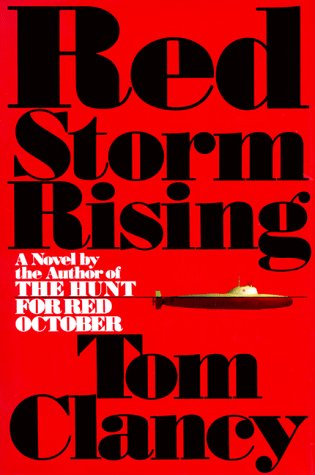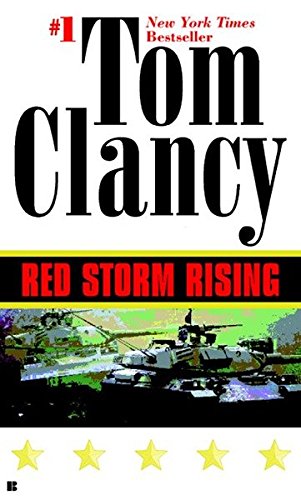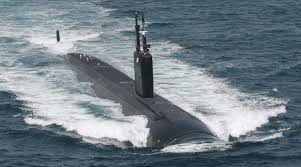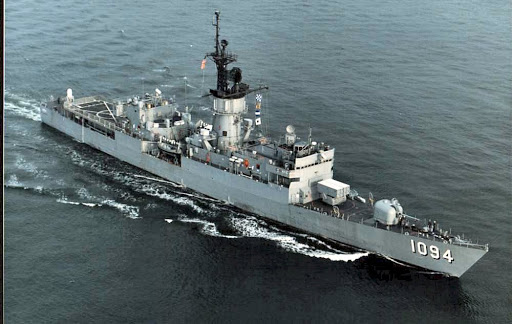
On August 7, 1986, G.P. Putnam’s Sons published Red Storm Rising, a novel by Tom Clancy. Set sometime in the late 1980s – Clancy and his uncredited co-author Larry Bond never specifically mention a year in the text – Red Storm Rising is a military thriller that, as in The Hunt for Red October, Clancy’s debut novel, focuses on the rivalry between the United States and the Soviet Union during the last years of the Cold War.
But where The Hunt for Red October was a novel that concerned itself with a story that blended a traditional “keeping the balance of power stable” plot that was a staple of Cold War fiction and elements of C.S. Forester’s novels with naval themes a la The Good Shepherd and The Last Nine Days of the Bismarck, Red Storm Rising is a more ambitious project: a full-on “Cold War-turns-hot” novel depicting a Third World War, complete with battles in the air, land, sea, and even in low-Earth orbit.

Red Storm Rising begins on a cold winter night in western Siberia as three Azerbaijani Islamic radicals – Ibrahim Tolkaze, a Soviet-trained oil field engineer, and his two associates, Rasul and Mohammet – set out on a deadly mission. Its goal: to destroy the refinery near the city of Nizhnevartovsk by sabotaging large sections of the pipelines and infiltrating the main control center to kill anyone capable of reversing or minimizing the damage from the terrorists’ efforts. Tolkaze and his friends are motivated by religious fervor and longstanding resentment toward their Russian overlords’ overt acts of racism and the USSR’s official imposition of atheism over Azerbaijan’s Islamic majority.
The radicals’ mission is a complete success, even though they are killed by a KGB quick reaction force summoned by frantic calls from several of the doomed oil facility engineers before they are executed by the three terrorists. As Tolkaze manages to shout a defiant cry of “Allahu Akbar!”before a KGB soldier cuts him down with a burst from his Kalashnikov assault rifle, much of the Nizhnevartovsk refinery goes up in a hell-storm of fire and smoke.
When Energy Minister Mikhail Sergetov, a junior (non-voting) member of the Communist Party’s Politburo returns to the Kremlin in Moscow after surveying the damage, he shocks his colleagues with his preliminary report. The refinery not only was infiltrated and almost totally destroyed by an insider attack – made possible by a Moscow edict to assign oil workers from the Soviet Socialist Republic of Azerbaijan to Siberia (a policy that Sergetov had objected to when it was originally proposed) – but its loss will result in a 33% reduction in the Soviet Union’s oil supply.
Sergetov, a “young” technocrat in his fifties, is a loyal Party member, but he is also a professionally-trained engineer and tells his fellow members of the Politburo the truth as he sees it. Yes, he says, the Nizhnevartovsk disaster is a serious blow to the nation’s economy, which is presently already laboring under the weight of inefficient policies and existing fuel shortages. With the temporary loss of the sabotaged refinery, there simply isn’t enough oil, gasoline, and aviation fuel to meet the demands of both the civilian economy and the massive Soviet military, particularly its large conventional ground forces, air forces, and navy.
But, Sergetov adds optimistically, if the Kremlin cuts fuel expenditures by the military and reaches out to the West, particularly the United States and Western Europe to buy the hardware needed to repair the damage in the Siberian facility while increasing production in other Soviet oil industry facilities, the oil shortage will be painful in the short run, but it can be dealt with.
However, most of the voting members in the Politburo, especially the unnamed Defense Minister and Boris Kosov, head of the KGB, argue that admitting to the West – the Soviet Union’s capitalist adversaries – that they need help of any sort is an admission of weakness. As the Defense Minister – a hardliner – remarks after Sergetov suggests asking for Western aid:
“Then I will tell you why this situation is unacceptable. If we do as you suggest, the West will learn of our crisis. Increased purchases of oil production equipment and unconcealable signs of activity at Nizhnevartovsk will demonstrate to them all too clearly what is happening here. That will make us vulnerable in their eyes. Such vulnerability will be exploited. And, at the same time” – he pounded his fist on the table – “you propose reducing the fuel available to the forces who defend us against the West?”
Sergetov tries to use reason to convince the senior members of the Politburo to seek help from America and her NATO allies. He tells his vociferous inquisitor, “Comrade Defense Minister, I am an engineer, not a soldier. You asked me for a technical evaluation, and I gave it.” Sergetov kept his voice reasonable. “This situation is very serious, but it does not, for example, affect our Strategic Rocket Forces. Cannot they alone shield us against the Imperialists during our recovery period?” Why else had they been built? Sergetov asked himself. All that money sunk into unproductive holes. Wasn’t it enough to kill the West ten times over? Why twenty times? And now this wasn’t enough?
“And it has not occurred to you that the West will not allow us to purchase what we need?” the Party theoretician asked.
“When have the capitalists refused to sell us –“
“When have the capitalists had such a weapon to use against us?” the General Secretary observed. “For the first time, the West has the ability to strangle us in a single year. What if now they also prevent our purchase of grain?”
In the novel’s second chapter, Odd Man In, Clancy creates a portrait of the inefficient Soviet system’s weaknesses, especially its overreliance on planned economic goals – Sergetov notes that the grain harvests in the USSR have failed to meet the state quotas for the past seven years in an 11-year time span. Combined with lower-than-normal harvests in Argentina and Australia, two of the USSR’s main foreign sources of wheat and other consumable grains, as well as the potential of difficulties in purchasing grain from the U.S. and Canada, the fearful old men of the Communist Party see a nightmare scenario of a Soviet populace deprived of electricity, the means of production, and even food.
“If We Cannot Buy Oil, We Must Take It…”

Unwilling to see reason, the hardliners make a decision born out of a combination of fear and the desire to hold on to power over the vast population of the Soviet empire. Why buy oil from a possibly unwilling West when there are vast reserves in the Persian Gulf region, which is within comfortable striking range of the Soviet armed forces? A lightning campaign featuring airborne drops on the oil production regions of Iran and Iraq, supported by a combined arms force of ground troops and tactical aviation, will provide the Soviet Union with the petroleum supplies it needs.
But before the Soviets move in the Middle East, they must neutralize the North Atlantic Treaty Organization and prevent it from reacting militarily. Aided by analyses from Chairman Kosov’s KGB and the military intelligence agency, the GRU, the Politburo decides to use every means necessary to divide NATO politically and lull it into a false sense of security before the Red Army and the Warsaw Pact invade West Germany.
Over the next four months, the Soviet leadership carries out a series of deceptions – maskirovkas – to distract attention from the preparations for Operation Red Storm, the invasion of West Germany. These include:
- The public announcement by the Soviets of a new disarmament treaty with the West that includes the unilateral scrapping of entire classes of obsolete Red Navy submarines
- Soviet TV airs a series of movies by Sergei Eisenstein, including Battleship Potemkin and Alexander Nevsky to arouse feelings of nationalism and patriotic fervor in the USSR prior to the start of hostilities
- A KGB team’s “false flag” bombing of a building in the Council of Ministers section of the Kremlin that is timed to coincide with a visit by schoolchildren from the city of Pskov. Seven children are killed, as well as a few minor Party officials. A KGB agent, posing as a West German sleeper agent named “Gerhardt Falken,” is publicly accused
- The Kremlin, in an attempt to justify the military invasion of West Germany, accuses the Bonn government and German “revanchists” of the Kremlin Bomb Plot and demands reparations
- Prior to the opening of Red Storm, Spetsnaz operatives infiltrate West Germany and prepare to strike at various NATO installations. However, one team is accidentally exposed when its leader is hit by a car and his identity as a Soviet officer is discovered before the Spetsnaz strike team reaches its target

Although U.S. satellites monitored the explosion and fires at Nizhnevartovsk in real time, American and allied intelligence agencies are oblivious to the economic fallout of the disaster, in part due to Soviet attempts to disseminate false information about the incident and thus hide the Soviet Union’s poor economic situation. As a result, American intelligence professionals such as National Security Agency analyst Bob Toland – who is also a lieutenant commander in the U.S. Naval Reserve – and Marine Corps Colonel Charles “Chuck” Lowe, who Toland meets in the Navy’s Atlantic Fleet headquarters in Norfolk (Virginia) during his annual “two-weeks” summer stint in uniform as a fleet intelligence officer.
Like Clancy’s best-known character, CIA analyst Jack Ryan, Toland is a keen observer of trends and patterns in an adversary, and it is he, along with his Marine counterpart, who first notices unusual actions by the Soviets, such as a sudden shortage of batteries for cars, trucks, and other vehicles in the Soviet civilian economy – even though the country’s main manufacturer is working overtime. Simultaneously, most of the Red Navy’s submarine fleet is called in to its bases for overhauls and replenishment of arms and fuel.
As a result of NATO’s discovery of the Soviets’ planned Spetsnaz operations in West Germany and other Soviet preparations for war, including field exercises that are actually cover for the massive buildup of Warsaw Pact units on the eastern side of the Inter-German Border, the Western alliance not only mobilizes its armed forces, but gets in the first blows by using Stealth fighters (the fictional F-19 Ghostriders, not the F-117A Nighthawks that had not yet been made public by the Pentagon) to shoot down Soviet airborne early warning and control (AEWC) planes and bomb badly-needed bridges over the River Elbe to slow down the invasion NATO now knows is coming.
In the midst of the new Third World War, we meet a cast of characters that are both complex and well-developed – on both sides – that made Red Storm Rising one of the biggest best-sellers of the Eighties, including:
- Pavel Leonidovich Alekseyev: Deputy Commander of the Southwest Front and then Commander in Chief-Western Theater, one of the planners of Red Storm who develops serious doubts about the war and his own government
- Lt. Commander Daniel X. McCafferty, USN: Commanding officer of the Los Angeles-class submarine USS Chicago and, along with Ed Morris, one of Bob Toland’s friends from Toland’s brief career as an active Navy officer
- Colonel Douglas “Duke” Ellington: U.S. Air Force pilot and commander of the F-19 Stealth squadron
- Ivan Mikhailovich Sergetov: Captain (later Major) in the Red Army and aide to P.L. Alekseyev; son of Politburo member Mikhail Sergetov
- Lt. Commander Edward Morris, USN: Commanding officer of USS Pharris and later USS Reuben James, friend of “bubblehead” Danny McCafferty and Bob Toland who sees action in the North Atlantic as part of NATO’s efforts to secure the sea lines of communication between North America and Western Europe
- 1st Lt. Michael D. Edwards, Jr., USAF: Meteorologist stationed at Keflavik Air Base on Iceland
- Boris Georgiyevich Kosov: Shady Chairman of the KGB who plays dangerous power games in the Kremlin
- Major Amelia “Buns” Nakamura, USAF: F-15C pilot who becomes the first American female fighter ace
- Marshal Andre Shavyrin: Chief of the Soviet General Staff in Moscow
- Lt. Commander Jerry “The Hammer” O’Malley, SH-60 Seahawk pilot attached to the Perry-class frigate USS Reuben James
- Vigdis Agustdottir: Icelandic civilian rescued by Mike Edwards from Soviet paratroopers who murdered her family – including the pet dog – and were attempting to rape her
My Take

I was introduced to the books of the late Tom Clancy by Dr. Charles Cox, my American History (Honors) professor at what was then Miami-Dade Community College – South Campus in the spring of 1986. I had given an oral presentation – my least favorite type of academic work, as I am not comfortable speaking in groups – about the World War II Battle of Midway. Apparently I made a good impression on the professor, because after class he walked up to me and said, “You seem to like naval history. Have you read Tom Clancy’s The Hunt for Red October? It’s a work of fiction, but it’s very well written.”
I had seen the paperback edition for sale at the campus bookstore, even held a copy in my hands and read the blurb, but at the time I wasn’t sure if I would like it and I put it back in its rack. However, if a professor with a Ph.D in history was recommending it….
So, I bought the Berkeley paperback of The Hunt for Red October and read it in my spare time [1]between classes or my hours College Work-Study job at the campus’ student newspaper office. At first, I didn’t think too much of Clancy’s writing style, but once I got into his tale of a defecting Soviet missile sub commander and his theft – aided by like-minded officers with personal grudges against the Communist state – of the Red Navy’s newest and stealthiest “boomer,” I could not put the book down.
Back then in those last years before the Internet, I found out about new books from reviews in the Miami Herald or Time magazine, as well as through monthly Preferred Readers’ Club newsletters. So I probably didn’t go to the nearest Walden Books store at the Miami International Mall when Red Storm Rising came out on August 7, 1986 but sometime afterward, because I distinctly remember reading the review in an issue of Time magazine, which called the novel “harrowing…tense…with a chilling ring of truth.”
I bought the hardcover edition soon after that; I was a fan of the hypothetical war genre, having read General Sir John Hackett’s The Third World War: August 1985 and its sequel, The Third World War: The Untold Story when I was in high school. Back then, too, even though Mikhail Gorbachev was attempting to reform the Soviet state and ease tensions with the West, I worried a great deal about the Cold War turning hot in my lifetime. So I had a somewhat morbid fascination with the possibility of a war between the United States and the Soviet Union, although by the late Eighties – and the end of Ronald Reagan’s Presidency – I was convinced that Gorbachev meant what he said about restructuring the corrupt and cruel Soviet system, and that World War III would be averted.
Looking back on this period of my life nearly 40 years after the fact, I think I must have read Red Storm Rising at least 10 times while I was still in college, and countless times since then. Since 1986, I have owned three hardcover copies; two of those I read so often that they literally fell apart. I bought the copy I have now sometime in the late 1990s; it’s still in good shape because I read Red Storm Rising less frequently and in different formats, including paperback and e-book editions.
For me, the appeal of Red Storm Rising – back then, anyway – was that of all the novels and stories I’d read about a possible “future war” between the Soviets and the West, it doesn’t end with an apocalyptic exchange of thermonuclear weapons at the climax of the conflict. Oh, nuclear weapons are on the backs of everyone’s mind, particularly among the Soviet leadership, but Clancy and Larry Bond – an ex-Naval officer turned wargame designer known for creating the Harpoon series of board and computer games – keep their Third World War strictly conventional.
As Clancy says in his Author’s Note:
“This book began sometime ago. I got to know Larry Bond through an advertisement in the U.S. Naval Institute Proceedings, when I purchased his war game, ‘Harpoon.’ It turned out to be amazingly useful, and served as a primary source for The Hunt for Red October. I was intrigued enough about it that I drove to a wargamers’ convention that summer (1982) to meet him in person, and we ended up becoming close friends[2].”
Red Storm Rising came about when Clancy, whose seminal novel The Hunt for Red October was in its pre-production stage at the Naval Institute Press, which would publish it in hardcover as its first fiction offering. According to Clancy, ”Larry and I started talking about one of his projects: ‘Convoy-84,’ a macrowargame or ‘campaign’ game which, using the ‘Harpoon’ system, would fight out a new Battle of the North Atlantic. I thought this was fascinating and we began talking about building a book around the idea, since, we both agreed, no one outside the Defense Department had ever examined in adequate detail what such a campaign would be like with modern weapons.”
As a result of this focus on a Third Battle of the Atlantic, Red Storm Rising spends a lot of time following the comings and goings of three American Navy officers; a reservist named Robert Toland – one of two American “Everyman” characters in the novel – and his two career Navy friends, submarine commander Danny McCafferty and escort ship skipper Ed Morris.
In the novel, we are told that Toland started out in the Navy as a career man, too, but that a mishap that involved an ambiguity on a navigation chart while he was officer of the deck aboard a destroyer led to a grounding of the ship on a sandbar – and blemished his otherwise sterling record as a Navy officer. Knowing that the incident will prevent him from ever commanding his own ship, Toland left the active duty Navy and joined its Reserve as an intelligence specialist. This billet dovetails nicely with Bob’s full-time job as an analyst – with a specialty on Soviet Navy matters – for the National Security Agency (NSA).
The war gives Toland a means to redeem himself as a naval officer, although he witnesses first hand one of the Soviets’ early victories – a successful attack on a U.S. amphibious force and its covering aircraft carrier battle group by missile-armed Backfire bomber in the North Atlantic. Toland – and thousands of sailors and airmen –survive the Soviet attack that seriously damages the carrier USS Nimitz and causes the postponement of a NATO landing on Iceland, but are reminded that America’s most powerful warships are also the Soviets’ No. 1 targets.

Meanwhile, Daniel McCafferty takes his Los Angeles-class fast attack sub, USS Chicago, in harm’s way on several missions in the Norwegian Sea and other waters near the Soviet naval and air bases on the Kola Peninsula. Throughout the conflict, McCafferty and the crew of Chicago experience frustration, fear, and adrenaline highs in a series of clashes with Soviet subs and warships, including an interception of a Soviet amphibious force off the coast of Norway, a hunt for an enemy “boomer bastion,” and a daring cruise missile raid on a Northern Fleet Backfire bomber base utilizing Tomahawk Land Attack Missiles (TLAMs).[3]

As for Ed Morris, Toland’s other buddy from his time in the regular Navy, he is in command of the USS Pharris, a Knox-class frigate that provides escort to convoys carrying troops and materiel to Europe from the East Coast of the U.S. Like Toland aboard USS Nimitz, Morris finds himself – along with his officers and crew – in the crosshairs of the Soviet Navy and is shaken to the core when his ship is torpedoed and badly damaged by a Soviet submarine during one of those perilous transatlantic crossings. Haunted by the deaths of some of his crew and the near-loss of his frigate, Morris must fight his inner demons when the Navy reassigns him to command a new Perry-class ship, USS Reuben James.

Although Clancy’s (and Bond’s, too, though he is on record as saying that he only contributed 1% of the novel’s content) sympathies lie with the Americans and NATO – and thus the outcome of the war is not a mystery – Red Storm Rising does not portray the Soviet adversaries as cartoony villains with no redeeming qualities.
For instance, Energy Secretary Mikhail Sergetov, one of the few members of the Politburo who opposes the war, is possibly based, in some level, on Mikhail Gorbachev, as they are both “young” technocrats in their fifties who love their country and believe in Communism, but realize that the Soviet system needs reform and are in favor of true peaceful coexistence with the West.
Some of the senior Soviet commanders are also portrayed sympathetically in Red Storm Rising, particularly Pavel Alekseyev, who helps plan Red Storm despite having strong misgivings about its prospects. Although he starts the war as second-in-command to a general in charge of the “theater” that will invade the Middle East if Red Storm succeeds, he and his superior are reassigned when the Stealth fighter bombers kill Commander in Chief West in the early days of the Red Army’s incursion into West Germany. Once there, Gen. Alekseyev and his aide-de-camp, Ivan Sergetov, find reasons to doubt the Politburo’s wisdom in starting the war – and end up asking themselves if loyalty to the Communist Party is the same as loyalty to the nation…and its people.
Clancy has no love for the Soviet system, and his distaste for Communist Russia shows in the way he describes the bigotry and suppression that Great Russians who are loyal to the Party deal out to the now-defunct Soviet Union’s ethnic and religious minorities. Ibrahim Tolkaze, the Islamic radical whose terrorist act triggers the plot of the novel, is motivated by resentment over how Russians, who were the dominant ethnic group in the USSR, treated Azerbaijanis during the Soviet era, using “Russification” to erase Azerbaijan’s cultural heritage and violently suppressing the mostly-Muslim population’s religious faith. Clancy does not excuse Tolkaze’s methods but uses his brief story arc to illustrate the evils of the Soviet system and the dangers of radicalizing any minority through repressive policies.
That having been said, it’s evident that Clancy admires the resiliency of the Russian character, and some of the book’s most masterful military moves are made by innovative Soviet commanders, including the invasion of Iceland by an airborne division in an operation called Polar Glory. Other Soviet “first moves” are shown as being imaginative in concept, such as the use of Spetsnaz operatives to commit acts of sabotage, but are thwarted by random acts of fate – and not solely by clever Western military or intelligence officers.
Clancy never was as good a prose writer as Stephen King; he tended to write in a style that was workmanlike and straight-to-the point without any pretense to be “artistic.” I think it was Alec Baldwin (who was the first of five actors to play Clancy’s best-known protagonist, Jack Ryan) who said Clancy used to write five pages’ worth of description to describe how a pencil worked. And for the longest time, every time I read a Tom Clancy novel – especially during his heyday in the Eighties and Nineties – I found that almost all of his characters “sounded” alike in my head when they had spoken dialogue.
Still, he could tell stories well, and for folks who lived during the last years of the Cold War, especially in the post-Vietnam War period when most movies and novels about the CIA and the military portrayed them in cynical and antagonistic fashion, Clancy’s positive view of America’s armed forces and the intelligence community were refreshing and, dare I say, a welcome change.
I like many of Clancy’s novels and his non-fiction books about the military, especially his early 1990s Guided Tour series, which he co-wrote with military researcher John D. Gresham. I tend to favor his earlier works over his pre-2013 books, especially the novels that Clancy wrote before 2003’s The Teeth of the Tiger, which is one of his one of his lesser efforts in my view.
Of these early books, Red Storm Rising is clearly my all-time favorite. This was Clancy – and to some extent, Larry Bond – at the top of his game. The major characters are fully fleshed out and believable, and the battle sequences on land, at sea, and in the air are vivid, realistic, and have a martial lyricism that evoke an emotional response from the reader.
As the reviewer from the New York Times wrote in his review, which G.P. Putnam’s Sons later quoted in their “blurbs” page, Red Storm Rising is “a rattling good yarn…full of action.”
[1] I was attending school year ‘round thanks to a Pell Grant that I was eligible for because of my mom’s status as a low-income widow. I signed up for classes during every semester, including the shorter Spring and Summer terms, mainly to get as many required courses out of the way so I could work on the college student paper and earn valuable class credits.
[2] Clancy, Tom. Red Storm Rising. Penguin Publishing Group. Kindle Edition.
[3] This was the basis for MicroProse’s Red Storm Rising computer game, which focuses on submarine warfare but also derives its backstory from Clancy’s novel, as events from the book are mentioned either in the title sequence of the game and form part of the context of the missions in the game.

Comments
7 responses to “Book Review: ‘Red Storm Rising’”
I’ve read The Hunt For Red October but never got deeply into Clancy. Perhaps I’ll put him on my audio book list and I’ll fare better trying that way. Your review certainly makes this very intriguing
LikeLiked by 1 person
This one is one of his best; you can’t go wrong with the audiobook; I just bought that this morning as my first digital audiobook to accompany my Kindle edition. If you want to really enjoy it, just think of it as a Harry Turtledove alt-history novel!
LikeLiked by 1 person
Getting through Shakespeare first, lol. But yes, I will try it.
LikeLike
When you mentioned the USS Reuben James. it dawned on me that he also uses that ship in the Hunt for Red October.
LikeLiked by 1 person
The movie version of Red October, which was written by Larry Ferguson (who plays the Dallas’ Chief of the Boat or COB) and Donald E. Stewart, certainly does use the Reuben James.
Clancy, who was not happy with the way Hollywood adapted his novels, was only involved in the production of The Sum of All Fears (he was one of its executive producers). And even then, he wasn’t pleased with the script for it. You should listen to his audio commentary there…he criticizes everything! 🙂
LikeLike
[…] [1] See my review of Red Storm Rising. […]
LikeLike
[…] Reviewer’s Note: This review is not about Tom Clancy’s novel Red Storm Rising; it’s about the audiobook edition of that 1986 book. For an in-depth look at one of the 1980s’ runaway best-selling novels, you can read my review here: Book Review: Red Storm Rising. […]
LikeLike